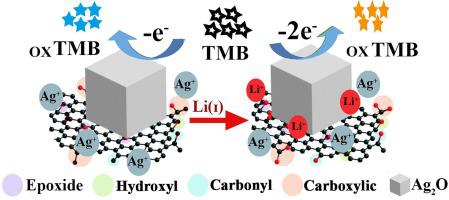当前位置:
X-MOL 学术
›
Ultrason. Sonochem.
›
论文详情
Our official English website, www.x-mol.net, welcomes your feedback! (Note: you will need to create a separate account there.)
Sonochemical synthesis of graphene oxide-Ag2O nanozyme as an oxidize-like mimic for the highly sensitive detection of lithium in blood serum
Ultrasonics Sonochemistry ( IF 8.7 ) Pub Date : 2024-06-17 , DOI: 10.1016/j.ultsonch.2024.106960 Maryam Entezari Khorasani , Majid Darroudi , Tahereh Rohani Bastami , Vahid Mahmoudi
Ultrasonics Sonochemistry ( IF 8.7 ) Pub Date : 2024-06-17 , DOI: 10.1016/j.ultsonch.2024.106960 Maryam Entezari Khorasani , Majid Darroudi , Tahereh Rohani Bastami , Vahid Mahmoudi

|
Bipolar disorder is commonly treated with lithium carbonate. The concentration of lithium in the blood serum should be closely monitored in patients who require long-term lithium therapy. To date, no colorimetric method of detecting lithium ions has been reported using nanosensors. We have developed a novel chemosensor based on nanozyme (NZ) to address this clinical need. The GO-AgO NZs were synthesized by a sonochemical method and used as a colorimetric nanosensor to detect lithium ions in human blood serum (Li (I)). To characterize NZs, various techniques were employed, including XRD, FTIR, TEM, FESEM, EDX, Raman spectroscopy, BET, DLS, Zeta potential, and ICP-OES. According to TEM and FESEM images of GO-AgO, the nanoparticles (NPs) of AgO are uniformly distributed on the surface of 2D graphene oxide sheets. In addition, silver oxide nanoparticles exhibited a cubic morphology with an average size of 3.5 nm. We have examined the performance of the NZs in an aqueous medium and in human blood serum that contains Li (I). A colorimetric test revealed that NZs synthesized in the presence of ultrasound were more sensitive to Li (I). According to the linearity of the calibration curves’ ranges, Li (I) has a limit of detection (LOD) of 0.01 µg/mL. Furthermore, it displayed a linear range between 0 and 12 µg/mL. GO-AgO NZs showed noticeable color changes from green to orange after exposure to Li (I). An incubation time of two minutes was found to be the most effective for sensing. This innovative approach provides a reliable method for monitoring lithium levels and ensuring patient safety during long-term lithium therapy for bipolar disorder.
中文翻译:

声化学合成氧化石墨烯-Ag2O纳米酶作为类氧化物模拟物,用于高灵敏度检测血清中的锂
双相情感障碍通常用碳酸锂治疗。对于需要长期锂治疗的患者,应密切监测血清中锂的浓度。迄今为止,尚未报道使用纳米传感器检测锂离子的比色方法。我们开发了一种基于纳米酶 (NZ) 的新型化学传感器来满足这一临床需求。通过声化学方法合成GO-AgO NZs,并用作比色纳米传感器来检测人血清中的锂离子(Li(I))。为了表征 NZ,采用了多种技术,包括 XRD、FTIR、TEM、FESEM、EDX、拉曼光谱、BET、DLS、Zeta 电位和 ICP-OES。根据 GO-AgO 的 TEM 和 FESEM 图像,AgO 纳米颗粒(NP)均匀分布在二维氧化石墨烯片的表面上。此外,氧化银纳米颗粒呈现立方形形态,平均尺寸为 3.5 nm。我们检查了 NZ 在水介质和含有 Li (I) 的人血清中的性能。比色测试表明,在超声波存在下合成的 NZ 对 Li (I) 更敏感。根据校准曲线范围的线性,Li (I) 的检测限 (LOD) 为 0.01 µg/mL。此外,它显示出 0 至 12 µg/mL 之间的线性范围。暴露于 Li (I) 后,GO-AgO NZ 表现出明显的颜色变化,从绿色变为橙色。发现两分钟的孵育时间对于传感来说是最有效的。这种创新方法为监测锂含量并确保双相情感障碍长期锂治疗期间患者的安全提供了可靠的方法。
更新日期:2024-06-17
中文翻译:

声化学合成氧化石墨烯-Ag2O纳米酶作为类氧化物模拟物,用于高灵敏度检测血清中的锂
双相情感障碍通常用碳酸锂治疗。对于需要长期锂治疗的患者,应密切监测血清中锂的浓度。迄今为止,尚未报道使用纳米传感器检测锂离子的比色方法。我们开发了一种基于纳米酶 (NZ) 的新型化学传感器来满足这一临床需求。通过声化学方法合成GO-AgO NZs,并用作比色纳米传感器来检测人血清中的锂离子(Li(I))。为了表征 NZ,采用了多种技术,包括 XRD、FTIR、TEM、FESEM、EDX、拉曼光谱、BET、DLS、Zeta 电位和 ICP-OES。根据 GO-AgO 的 TEM 和 FESEM 图像,AgO 纳米颗粒(NP)均匀分布在二维氧化石墨烯片的表面上。此外,氧化银纳米颗粒呈现立方形形态,平均尺寸为 3.5 nm。我们检查了 NZ 在水介质和含有 Li (I) 的人血清中的性能。比色测试表明,在超声波存在下合成的 NZ 对 Li (I) 更敏感。根据校准曲线范围的线性,Li (I) 的检测限 (LOD) 为 0.01 µg/mL。此外,它显示出 0 至 12 µg/mL 之间的线性范围。暴露于 Li (I) 后,GO-AgO NZ 表现出明显的颜色变化,从绿色变为橙色。发现两分钟的孵育时间对于传感来说是最有效的。这种创新方法为监测锂含量并确保双相情感障碍长期锂治疗期间患者的安全提供了可靠的方法。












































 京公网安备 11010802027423号
京公网安备 11010802027423号